You are using an out of date browser. It may not display this or other websites correctly.
You should upgrade or use an alternative browser.
You should upgrade or use an alternative browser.
The General Airplane Thread
- Thread starter Crash
- 2,747 comments
- 207,723 views
- 6,425

- KCCO
As long as there is sufficient lift over the wings, yes. Also, provided that there is some means of making sure it doesn't get blown backwards either.Is it possible to keep an airplane airborne by hanging it in front of a very powerful wind tunnel?
Carlos
Premium
- 6,454

- Netherlands
Is it possible to keep an airplane airborne by hanging it in front of a very powerful wind tunnel?
As long as there is sufficient lift over the wings, yes. Also, provided that there is some means of making sure it doesn't get blown backwards either.
It would even be possible to fly ‘backwards’ if the lift and headwind is strong enough
 A super stol could achieve this realistically.
A super stol could achieve this realistically.- 6,104

- Finland
It would even be possible to fly ‘backwards’ if the lift and headwind is strong enoughA super stol could achieve this realistically.
Easily achieved by the wartime Fieseler Storch, its stalling speed was 50 km/h - less than 14 m/s - which isn't even that strong of a wind.
- 12,389

- Betelgeuse
- Beeblebrox_237
Is it possible to keep an airplane airborne by hanging it in front of a very powerful wind tunnel?
Welcome to the world of Alaskan bush pilots:It would even be possible to fly ‘backwards’ if the lift and headwind is strong enoughA super stol could achieve this realistically.
Carlos
Premium
- 6,454

- Netherlands
Welcome to the world of Alaskan bush pilots:
Those Piper Cubs are awesome!
- 2,720

- Knoxville, Tennessee
Someone said RC airplanes?


- 4,573

- Moscow
- Rage_Racer_VOLK
- RageRacer48

Found some photos of Mi-24R (also known as Mi-24KhR or Mi-24RKhR), a special version of the Crocodile that was used during the Chernobyl nuclear disaster in 1986. No, it didn't shoot mutants. It's designed for radiation and chemical reconnaisance.
On the wingtip pylons, the anti-tank missiles are replaced with scoops to collect soil samples for analysis. The cabin is airtight and the crew includes one or two recon chemists.



- 5,104

- Panama City, FL
My annual trek to NAS Pensacola for the Blue Angels final demonstration of the season. VERY low humidity, almost no vapor, but a brilliant clear sky and bright sunshine.
F-22 demonstration. This is the most vapor I got in any shot. In "normal" Florida humidity, the tail would probably be all we could see of the aircraft.

Photo pass. Compare that to my rainy-day shot here, from 3 years ago at Tyndall AFB.

High speed flat pass, just barely subsonic.

USAF heritage Flight.
The P-51 is closer, with the F-22 flying his left wing.

I was at the very right-hand end of the crowd line, almost a mile from my "regular" place just a bit left of center. That meant I could see some formations approaching from behind the crowd, though, like this photo pass, behind and to the right as they approach. This view lets you see how they "stack" the formation in an offset manner to give the overlap view that the crowd sees in front of the show line. Each aircraft is actually a bit to the right of a "centered" formation on the leader.

And in front of the crowd:
#3 is under #1's wingtip, about 18 inches clearance. It looks like #2 is as well, but that would be impossible, as 2 and 3 would have to overlap each other. That's the perspective trick from the offset formation. Then #4 is under #2's wing, the same as 3 under 1, but the perspective makes it look like he's splitting the difference.

Carrier landing configuration, with #5 inverted

Heat haze!!!! If I can't get vapor, at least I got me some heat haze!

#1 and #4 inverted, what they call the Double Farvel

Echelon right, again still behind the crowd from the right

And in front of the crowd

I only got one opposing crossover shot today

5-ship line abreast loop

Delta roll

Pitch-up for landing.
I've never shot this before, as from my usual spot, they've passed me by the time this happens.

First day out with my "new" D7200, rather than my "old" D7000. The 7200 is much improved as far as continuous burst speed and buffer size. The 7000 was done at 9 shots, max 6 fps. The 7200 can do 8 fps for 25 or 30 shots. It also has a generation newer image processor with MUCH lower noise and MUCH higher ISO available, and better auto-focusing, although the same number of sensors as the 7000.
F-22 demonstration. This is the most vapor I got in any shot. In "normal" Florida humidity, the tail would probably be all we could see of the aircraft.

Photo pass. Compare that to my rainy-day shot here, from 3 years ago at Tyndall AFB.

High speed flat pass, just barely subsonic.

USAF heritage Flight.
The P-51 is closer, with the F-22 flying his left wing.

I was at the very right-hand end of the crowd line, almost a mile from my "regular" place just a bit left of center. That meant I could see some formations approaching from behind the crowd, though, like this photo pass, behind and to the right as they approach. This view lets you see how they "stack" the formation in an offset manner to give the overlap view that the crowd sees in front of the show line. Each aircraft is actually a bit to the right of a "centered" formation on the leader.

And in front of the crowd:
#3 is under #1's wingtip, about 18 inches clearance. It looks like #2 is as well, but that would be impossible, as 2 and 3 would have to overlap each other. That's the perspective trick from the offset formation. Then #4 is under #2's wing, the same as 3 under 1, but the perspective makes it look like he's splitting the difference.

Carrier landing configuration, with #5 inverted

Heat haze!!!! If I can't get vapor, at least I got me some heat haze!


#1 and #4 inverted, what they call the Double Farvel

Echelon right, again still behind the crowd from the right

And in front of the crowd

I only got one opposing crossover shot today

5-ship line abreast loop

Delta roll

Pitch-up for landing.
I've never shot this before, as from my usual spot, they've passed me by the time this happens.

First day out with my "new" D7200, rather than my "old" D7000. The 7200 is much improved as far as continuous burst speed and buffer size. The 7000 was done at 9 shots, max 6 fps. The 7200 can do 8 fps for 25 or 30 shots. It also has a generation newer image processor with MUCH lower noise and MUCH higher ISO available, and better auto-focusing, although the same number of sensors as the 7000.
Last edited:
- 22,551

- Arizona
- HamiltonMP427
Just a minor observation: It’s interesting to see the contrast of American and Russian “boneyards.” Here in America, the final resting place for the majority of aircraft are in barren deserts, while the boneyards of Russia are in dense forests.
There is a reason we do that. Russia doesn't have much of a desert it only has the one if I recall correctly and it's not too vast.
Dan
Premium
- 15,396

- United States
There is a reason we do that. Russia doesn't have much of a desert it only has the one if I recall correctly and it's not too vast.
Oh yeah, I’m aware Russia isn’t known for their deserts.
- 22,551

- Arizona
- HamiltonMP427
Oh yeah, I’m aware Russia isn’t known for their deserts.
I'm sure you are, but for us we do it to preserve planes in case we need to bring them back to service, Desert is great for that. Russia I'm not so sure they're concerned with that since their planes run longer service lives it seems.
- 5,000

- United States
- GTP_Johnny1996
Last night I heard a very strange engine noise come from a plane flying overhead my house. It was comparable to the noise used in video games or cartoons when a plane is nose diving at high speed. Sometimes when I hear a plane flying over I'll go to Flightradar24 to see what it is, and I did that here. That was when I noticed a very sharp turn on the flight path, and given the weird noise I thought that something was wrong. I decided to watch the flight to see how things played out. Captions to their respective Flightradar24 screenshots are above the screenshots.
Here, "my house" is an approximate estimation given how close the sound seemed. "AGC" is the Allegheny County airport just outside of Pittsburgh, PA. Callsign "LBQ791" is the aircraft in question. At this point I was thinking the plane may have suffered an engine problem and had to make an emergency landing.
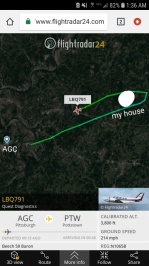
As I was watching the plane descend into AGC, it appeared to have to perform a go around. Then, the plane icon suddenly stopped all movement, speed and altitude tracking and froze. I waited a few minutes and nothing was new, and that's when I took this screenshot. This is also when I start feeling fairly uneasy not knowing if the aircraft had safely landed. I know that Flightradar's location isn't 100% accurate but going back to the weird noise I heard, I was still concerned.
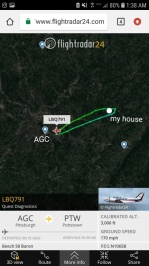
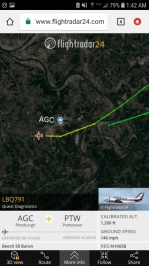
At this moment, the plane icon had suddenly disappeared. I had never seen this on FR24 before in nearly a year of using it other than when speed and altitude read 0 after landing and taxiing, presumably when the aircraft was shut off. The plane icon on screen here near the photo was not LBQ791; unfortunately I cannot remember what it was.
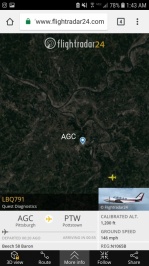
Suddenly, the airplane reappeared going the opposite direction. I went from feeling concerned to being confused as I thought the plane was on the ground somewhere. But at the speed and altitude shown here, it couldn't have landed. A touch and go perhaps, but not a full landing, which confuses me more wondering why they would perform one. Of course I could be wrong, and chances are I probably am.
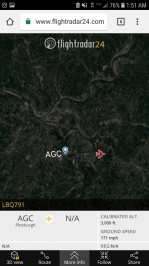
As I zoom out and follow LBQ791 some more as it moves east toward LBE (Latrobe Arnold Palmer in Latrobe, PA), a second plane randomly appears on top of the first one. I zoom in so I can click on each airplane icon for information, and it seems as though these are the same plane or two separate planes flying in very close formation. But why would the second plane appear out of nowhere? The "no callsign" plane is the second one, while LBQ791 is the first, original airplane I was tracking. Unfortunately I mislabeled its callsign but corrected it.
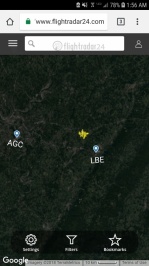
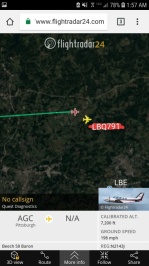
Suddenly, the second plane disappears and the original one is the only one there. I'm even more confused as to what's going on, but everything flight path and data wise seems normal. After I took this screenshot, I tracked LBQ791 some more until I decided that all was well. The flight was short, going to Pottstown Heritage airport (PTW) in Pennsylvania. By the time I've finished typing to this point, I find it safe to assume that the plane has landed at its destination. I can't find it at or near PTW.
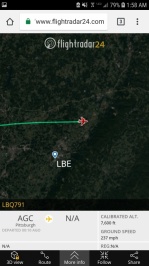
What I want to know, assuming anyone has answers, is what might have been going on? Why would the plane have gone back to its departure airport but seemingly not land, then continue back on its journey to its destination? And most importantly what could that strange noise have been? I definitely heard a propeller or turbo prop sound, and the strange noise sounded very much like the high speed nosedive sound used in cartoons and video games. Is there perhaps a chance that the pilot(s) had lost but regained control?
I'm definitely not as educated as some of you guys here might be, so this post may have been for nothing. But in case there are some answers or at least something new to learn, I appreciate it.
Here, "my house" is an approximate estimation given how close the sound seemed. "AGC" is the Allegheny County airport just outside of Pittsburgh, PA. Callsign "LBQ791" is the aircraft in question. At this point I was thinking the plane may have suffered an engine problem and had to make an emergency landing.

As I was watching the plane descend into AGC, it appeared to have to perform a go around. Then, the plane icon suddenly stopped all movement, speed and altitude tracking and froze. I waited a few minutes and nothing was new, and that's when I took this screenshot. This is also when I start feeling fairly uneasy not knowing if the aircraft had safely landed. I know that Flightradar's location isn't 100% accurate but going back to the weird noise I heard, I was still concerned.


At this moment, the plane icon had suddenly disappeared. I had never seen this on FR24 before in nearly a year of using it other than when speed and altitude read 0 after landing and taxiing, presumably when the aircraft was shut off. The plane icon on screen here near the photo was not LBQ791; unfortunately I cannot remember what it was.

Suddenly, the airplane reappeared going the opposite direction. I went from feeling concerned to being confused as I thought the plane was on the ground somewhere. But at the speed and altitude shown here, it couldn't have landed. A touch and go perhaps, but not a full landing, which confuses me more wondering why they would perform one. Of course I could be wrong, and chances are I probably am.

As I zoom out and follow LBQ791 some more as it moves east toward LBE (Latrobe Arnold Palmer in Latrobe, PA), a second plane randomly appears on top of the first one. I zoom in so I can click on each airplane icon for information, and it seems as though these are the same plane or two separate planes flying in very close formation. But why would the second plane appear out of nowhere? The "no callsign" plane is the second one, while LBQ791 is the first, original airplane I was tracking. Unfortunately I mislabeled its callsign but corrected it.


Suddenly, the second plane disappears and the original one is the only one there. I'm even more confused as to what's going on, but everything flight path and data wise seems normal. After I took this screenshot, I tracked LBQ791 some more until I decided that all was well. The flight was short, going to Pottstown Heritage airport (PTW) in Pennsylvania. By the time I've finished typing to this point, I find it safe to assume that the plane has landed at its destination. I can't find it at or near PTW.

What I want to know, assuming anyone has answers, is what might have been going on? Why would the plane have gone back to its departure airport but seemingly not land, then continue back on its journey to its destination? And most importantly what could that strange noise have been? I definitely heard a propeller or turbo prop sound, and the strange noise sounded very much like the high speed nosedive sound used in cartoons and video games. Is there perhaps a chance that the pilot(s) had lost but regained control?
I'm definitely not as educated as some of you guys here might be, so this post may have been for nothing. But in case there are some answers or at least something new to learn, I appreciate it.

- 22,551

- Arizona
- HamiltonMP427
When you says Propeller or Turbo Prop, do you mean Radial or Turboprop? That part is somewhat confusing to me, and I'm guessing the noise is that nose dive sound you hear in old Charlie Brown cartoons when Snoopy is fighting the Red Baron. I would guess that the pilot was having issues decided to head back to the airport and that he potentially lost altitude near your house, then got back to the airport potentially had to abort said landing because he didn't get rid of enough fuel, but that's hard to know without further details like TOW. However, let's say they could land at the weight they were at after such short airtime, there is a potential they did a go around or aborted the landing because of conditions in the area, again we're not giving that. I usually use airnav and flightaware for current conditions when I track aircraft or want to see the path for a certain travel plan.
However, that doesn't make much sense since they continued onward, and if there was an issue, I'm pretty sure the FARs state you have to land and get the aircraft in question checked out before proceeding on travel again. Perhaps they were directed to travel to another airport a little further away instead, I'm not traversed with the area, so I don't know how many county/municipal, regional and international airport are close by you but that'd be my guess. And then I'd couple that with perhaps a bad transponder reading between the website and the aircraft or just the website being weird as a higher altitude plane flew a path above but parallel to the lower flying one you were tracking.
This is assuming that the plane you were pathing was the plane you heard or even that it was the actual cause of said sound. I know this may irritate you in the last line because it's pretty recognizable but sometimes things sound like something and turn out to be something else entirely different I'm sure you're aware, it could be a case of that. Furthermore, you could have just happened to track a plane that was being weird with FR24 out of coincidence based on a the noise you heard. I'm sure other people will have their view points and I'd really enjoy seeing and reading those and hopefully expanding on what I perhaps missed.
However, that doesn't make much sense since they continued onward, and if there was an issue, I'm pretty sure the FARs state you have to land and get the aircraft in question checked out before proceeding on travel again. Perhaps they were directed to travel to another airport a little further away instead, I'm not traversed with the area, so I don't know how many county/municipal, regional and international airport are close by you but that'd be my guess. And then I'd couple that with perhaps a bad transponder reading between the website and the aircraft or just the website being weird as a higher altitude plane flew a path above but parallel to the lower flying one you were tracking.
This is assuming that the plane you were pathing was the plane you heard or even that it was the actual cause of said sound. I know this may irritate you in the last line because it's pretty recognizable but sometimes things sound like something and turn out to be something else entirely different I'm sure you're aware, it could be a case of that. Furthermore, you could have just happened to track a plane that was being weird with FR24 out of coincidence based on a the noise you heard. I'm sure other people will have their view points and I'd really enjoy seeing and reading those and hopefully expanding on what I perhaps missed.
Dan
Premium
- 15,396

- United States
That “nosedive” sound effect in movies and tv shows comes from sirens installed on the Junkers Ju-87 “Stuka” from WWII. These sirens (also known as “Jericho Trumpets”) were installed on the landing gear legs and were powered by the force of the wind, similar to how a ram-air turbine works. Anyway, as the air spun the siren, it produced a howling noise that increased in pitch at higher speeds. The Doppler effect also might have had a role in changing the sound while the Stukas were performing their bombing runs.
————
I regularly see aircraft flying under the LabQuest callsign (LBQ—) online. Typically they are carrying medical equipment, and the aircraft range from twin pistons such as the Beechcraft Baron, turboprops like Beechcraft King Airs and Pilatus PC-12, to light jets like the Embraer Phenom 100. Twin pistons like the Beechcraft Baron create an interesting sound, especially if both engines are at high power settings and the propellers are turning at different RPMs.
As for the flight path, I can’t say for sure what the pilot was doing. If there was an engine issue, it’s unlikely that they would have taken off again after landing. Light twins are notorious for their instability while flying on one engine. Something to remember is that most flight tracking sites can get a little screwy if something unexpected happens, like an aircraft diverting from one airport to another. I’ve seen FlightAware say that a plane has landed at my airport when it hasn’t (usually due to poor weather conditions). FlightAware might also show the aircraft in the air for several minutes in the same spot after it has already landed. I wouldn’t put 100% faith in these sites because they aren’t 100% accurate. My company use these sites every day to have an idea when aircraft are arriving so we can coordinate things on the ground, but we don’t trust it down to the minute.
————
I regularly see aircraft flying under the LabQuest callsign (LBQ—) online. Typically they are carrying medical equipment, and the aircraft range from twin pistons such as the Beechcraft Baron, turboprops like Beechcraft King Airs and Pilatus PC-12, to light jets like the Embraer Phenom 100. Twin pistons like the Beechcraft Baron create an interesting sound, especially if both engines are at high power settings and the propellers are turning at different RPMs.
As for the flight path, I can’t say for sure what the pilot was doing. If there was an engine issue, it’s unlikely that they would have taken off again after landing. Light twins are notorious for their instability while flying on one engine. Something to remember is that most flight tracking sites can get a little screwy if something unexpected happens, like an aircraft diverting from one airport to another. I’ve seen FlightAware say that a plane has landed at my airport when it hasn’t (usually due to poor weather conditions). FlightAware might also show the aircraft in the air for several minutes in the same spot after it has already landed. I wouldn’t put 100% faith in these sites because they aren’t 100% accurate. My company use these sites every day to have an idea when aircraft are arriving so we can coordinate things on the ground, but we don’t trust it down to the minute.
Obelisk
Premium
- 9,921

- United States
- RMedia_Obelisk
The SBD Dauntless had the same thing happen due to its dive brakes.That “nosedive” sound effect in movies and tv shows comes from sirens installed on the Junkers Ju-87 “Stuka” from WWII. These sirens (also known as “Jericho Trumpets”) were installed on the landing gear legs and were powered by the force of the wind, similar to how a ram-air turbine works. Anyway, as the air spun the siren, it produced a howling noise that increased in pitch at higher speeds. The Doppler effect also might have had a role in changing the sound while the Stukas were performing their bombing runs.
- 22,551

- Arizona
- HamiltonMP427
That “nosedive” sound effect in movies and tv shows comes from sirens installed on the Junkers Ju-87 “Stuka” from WWII. These sirens (also known as “Jericho Trumpets”) were installed on the landing gear legs and were powered by the force of the wind, similar to how a ram-air turbine works. Anyway, as the air spun the siren, it produced a howling noise that increased in pitch at higher speeds. The Doppler effect also might have had a role in changing the sound while the Stukas were performing their bombing runs.
Not sure what this has to do with solving the mystery you've posed. My point on the noise was there is a slight potential that you may have thought you heard that noise but in reality it was something else entirely.
I regularly see aircraft flying under the LabQuest callsign (LBQ—) online. Typically they are carrying medical equipment, and the aircraft range from twin pistons such as the Beechcraft Baron, turboprops like Beechcraft King Airs and Pilatus PC-12, to light jets like the Embraer Phenom 100. Twin pistons like the Beechcraft Baron create an interesting sound, especially if both engines are at high power settings and the propellers are turning at different RPMs.
Again what does this have to do with solving your mystery? So you're saying that it was probably a turboprop or otto cycle spark ignition engine, that you heard? All the Beachcraft Baron's I know of use six cylinder engines of varying degree and multitude. The interesting sound is probably from the higher end version of the Baron that run more than one engine that are turbocharged.
As for the flight path, I can’t say for sure what the pilot was doing. If there was an engine issue, it’s unlikely that they would have taken off again after landing. Light twins are notorious for their instability while flying on one engine. Something to remember is that most flight tracking sites can get a little screwy if something unexpected happens, like an aircraft diverting from one airport to another. I’ve seen FlightAware say that a plane has landed at my airport when it hasn’t (usually due to poor weather conditions). FlightAware might also show the aircraft in the air for several minutes in the same spot after it has already landed. I wouldn’t put 100% faith in these sites because they aren’t 100% accurate. My company use these sites every day to have an idea when aircraft are arriving so we can coordinate things on the ground, but we don’t trust it down to the minute.
I know you can't know for sure that's fine, I was simply giving my ideas on what possibly happened. Again yes it is unlikely they would have taken off, the FARs regulate this exact situation if it happened as such. I too have seen the issues with the various air tracking sites which is why I think that's more than likely what you encountered than any issue with the airplane. Also I'm glad you don't trust it down to the minute because one shouldn't since they're not exactly simulated to anyone specific airport, nor is trusting said simulation alone a good bet (as you're aware), but it does help as a secondary tool when working properly.
- 5,104

- Panama City, FL
I've heard the whistling sound of a high-speed dive on P-51s at air shows. Diving clean, no gear or flaps, just diving fast.
Can't help you with anything else you described, but I'm kind of of the mind, what's the point? It's like hearing a jake brake on a big truck for the first time, and thinking, "OMG! That truck made a HUGE engine noise, slowed down, but then continued on like nothing happened!!!" I don't mean to make light of your concern, but it's impossible to describe a sound with words to someone who hasn't heard it.
Can't help you with anything else you described, but I'm kind of of the mind, what's the point? It's like hearing a jake brake on a big truck for the first time, and thinking, "OMG! That truck made a HUGE engine noise, slowed down, but then continued on like nothing happened!!!" I don't mean to make light of your concern, but it's impossible to describe a sound with words to someone who hasn't heard it.
- 22,551

- Arizona
- HamiltonMP427
Meant to post this a year ago, but forgot about and recently found it when searching my phone. Was wondering if any of you knew what it was, I thought it was for an F-35 since it was a Military contracted transport truck, there was two of them as well. This one luckily didn't have the tarp
secured.

secured.
- 22,551

- Arizona
- HamiltonMP427
Yeah that’s definitely an F-35. The parts surrounding the exhaust are a little beefy for an F-16. I’m not sure why they would transport parts of an F-35 in an open trailer instead of a closed one, but the military works in mysterious ways.
Still not so sure about that, the nozzle doesn't seem to support much variation if any, it almost looked fixed. But it's hard to tell. Also if you look up engine installs for F-35 they all seem to have an instillation different from this transport. And I think the tarp was suppose to hide it but since they didn't secure it properly the wind got the better of it.
GTV0819
(Banned)
- 6,084

- Papua New Guinea
Lol good luck, Boeing.. Wrong decisions will always come to haunt you down, no matter how hard they try to cover themselves from it.
https://mobile.abc.net.au/news/2018-12-29/family-of-lion-air-co-pilot-sues-boeing-in-chicago-over-fatal-c/10673140?pfmredir=sm
https://mobile.abc.net.au/news/2018-12-29/family-of-lion-air-co-pilot-sues-boeing-in-chicago-over-fatal-c/10673140?pfmredir=sm
Last edited:
- 12,389

- Betelgeuse
- Beeblebrox_237
My understanding is that the sensors had exhibited issues which caused controllability issues on previous flights, and that these problems weren't fixed by the airline prior to the flight on which the plane crashed. In fact, the issues were so bad on the immediately preceding flight that the crew declared a state of urgency and considered diversion. Additionally, I've also read that the previous flight crew had been able to control the aircraft using Boeing procedures, but that initial indications were that the crew of Flight 610 didn't follow those procedures. The fact that the aircraft suffered serious problems and wasn't fixed before flying again makes me doubt Boeing will have any issue proving its innocence and showing that the carrier was negligent in its repair procedures.Lol good luck, Boeing.. Wrong decisions will always come to haunt you down.
https://mobile.abc.net.au/news/2018-12-29/family-of-lion-air-co-pilot-sues-boeing-in-chicago-over-fatal-c/10673140?pfmredir=sm
GTV0819
(Banned)
- 6,084

- Papua New Guinea
But then goes also the fact that Boeing didn't provide adequate information and lessons about these 'faulty' sensors of the 737MAX8 to the pilots and airlines who operated these planes in their flights.My understanding is that the sensors had exhibited issues which caused controllability issues on previous flights, and that these problems weren't fixed by the airline prior to the flight on which the plane crashed. In fact, the issues were so bad on the immediately preceding flight that the crew declared a state of urgency and considered diversion. Additionally, I've also read that the previous flight crew had been able to control the aircraft using Boeing procedures, but that initial indications were that the crew of Flight 610 didn't follow those procedures. The fact that the aircraft suffered serious problems and wasn't fixed before flying again makes me doubt Boeing will have any issue proving its innocence and showing that the carrier was negligent in its repair procedures.
If another serious incident happens again, that will really put them in a very big trouble.
- 22,551

- Arizona
- HamiltonMP427
But then goes also the fact that Boeing didn't provide adequate information and lessons about these 'faulty' sensors of the 737MAX8 to the pilots and airlines who operated these planes in their flights.
If another serious incident happens again, that will really put them in a very big trouble.
Yes they did, as Beeble just said and Boeing even stated. They only grounded all of these to do a sensor fix to overcome pilots who potentially didn't follow said procedure. Look I agree too an extent that this type of issue where the plane thinks it is stalling and goes in to a pitch down scenario seems very very bad from an engineering stand point. Why the stability of the aircraft in initial guise did this, is only something Boeing may ever know, however they gave info on how to make the plane stable in flight and that should of been followed. Some where in this someone is to blame, as much as I dislike Boeing I can't say it was them, I agree it was probably the airliner.
GTV0819
(Banned)
- 6,084

- Papua New Guinea
We should see, lol.Yes they did, as Beeble just said and Boeing even stated. They only grounded all of these to do a sensor fix to overcome pilots who potentially didn't follow said procedure. Look I agree too an extent that this type of issue where the plane thinks it is stalling and goes in to a pitch down scenario seems very very bad from an engineering stand point. Why the stability of the aircraft in initial guise did this, is only something Boeing may ever know, however they gave info on how to make the plane stable in flight and that should of been followed. Some where in this someone is to blame, as much as I dislike Boeing I can't say it was them, I agree it was probably the airliner.
I observed that people from Boeing are so full of themselves. If they could recall this plane, it will be better for the benefit of airlines and pilots but if they don't and let media cover it by bribing a lot of them, then still good luck.
It reminds me of an automaker in our country who didn't want to admit that one of their models have faulty accelerators which results in a sudden unintended acceleration, that they didn't want to make a recall about it and bribed the agency for them to not reveal that these have faulty accelerators and all.



